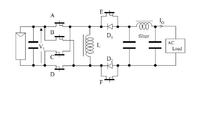amjadali56
Full Member level 3

thnx pnjbtr! i will post new schem soon.
Follow along with the video below to see how to install our site as a web app on your home screen.
Note: This feature may not be available in some browsers.




what are input and out put volts.



I think we can not gain optimal power from IRF250 with Dc 12v.Because its RDS is 85mil ohm,operating volt 200,difficult to saturate.with 12v dc.

Not good enough. The peak voltage of a sine-wave is 1.414 times its RMS voltage. So a 230V transformer needs the low voltage winding to be less than 12V/1.414= 8.5V. Maybe use a 8V-0-8V transformer.i think max 10.5+10.5/240 volt transformer is better.









